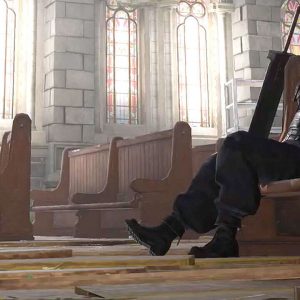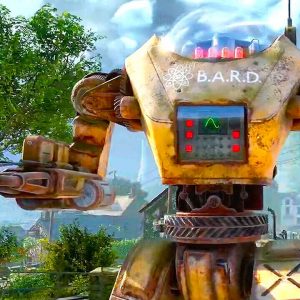There are few pleasures in video games that can contend with a quick, clean, silent kill. And there’s no better place to find that than in a stealth game. The sneakiest of all the genres, stealth can be quite a surgical thing – an experience that rewards considered, methodical planning. But with that comes the risk of mistakes, and a slip-up in a stealth game can result in another, equally thrilling ride: one where quick thinking and unconventional solutions can help you slip back into the shadows. What we’re saying here is that stealth games are incredibly malleable and creative, often designed to give you unparalleled freedom within the space of their intricately-designed levels.
But what are the very best stealth games? The coolest spy thrillers, and the ones with the deadliest assassins? Well, that’s what we’re here to divulge. This is IGN’s pick of the 10 best stealth games, a list created to explore the whole spectrum of sneaky experiences – from games that act as a gateway into the shadows, all the way up to precision assassin sims.
10. Tenchu: Stealth Assassins
1998 was the dawn of the 3D stealth game. It was the year of Thief: The Dark Project on PC and Metal Gear Solid on PlayStation. Pre-dating both of them by just a few months was Tenchu: Stealth Assassins, a PS1 ninja game that’s less celebrated than its sneaky cousins but just as ambitious.
Developer Acquire was working in completely uncharted territory for the era. Its Sengoku-period sandbox levels are patrolled by guards who have vision cones that are impaired by shadows. Your character – either the honourable Rikimaru or the more carefree Ayame – can shift through stances and press up against walls to keep out of sight. But hiding isn’t just a case of seeking out the darkest shadows; Tenchu features a grapple hook that can be attached to any solid surface, allowing you to easily zip up to the rooftops and survey the level from above. It’s in this design that you can see the seeds that will eventually become Assassin’s Creed – and echoes of Tenchu can especially be felt all around in the series’ latest game, Shadows.
But while evasion is an important part of Tenchu, it’s perhaps best remembered for its heightened bloodlust when compared to its contemporary peers. Provided you do so silently, you’re rewarded for kills in each end-of-level scorecard. A collection of ninja tools and elaborate animations coax you into smart assassinations, and the bloody swordplay is a delight. Considering how important combat is to Tenchu, it’s unsurprising to see how Sekiro grew out of it – FromSoftware’s own shinobi sim is not only inspired by this PS1 gem, it even started life as a sequel to it.
9. Sly 2: Band of Thieves
At a glance, Sly Cooper appears like any other early-2000s mascot platformer. But look a little deeper and you’ll find a much more subtle and smarter affair than its PlayStation 2 brethren were serving up at the time. Far from the loudness of Jak and Ratchet, Sly forgoes challenging platforming and colourful weaponry in favour of a more intricate, methodical approach. It may not involve the most complex stealth systems you’ll find on this list, but it is nonetheless a playful exercise in the genre’s fundamentals, and with Sly’s second effort, Band of Thieves, it really struck gold.
Switching between members of a heist-hungry crew made up of raccoon Sly Cooper, turtle Bentley, and hippo Murray is required to pull off the perfect scores, each of which takes place in one of a number of sizable open world maps. Each character cleverly embodies a different element of stealth-action design: Sly is agile and can stick to shadowy rooftops, Bentley is less mobile but can use gadgetry to hack tech and distract guards, and Murray can be called in when the alarm is raised and a helping of brawn is needed alongside the brains. Their missions are, admittedly, among the most forgiving in the entire genre, but each is incredibly playful in design — there’s even the option to plug in a USB microphone and use your own voice to lure enemies towards your location. Just be careful not to let out a sneeze.
To this day, Sly 2: Band of Thieves remains one of the fondest remembered PS2 games, and still serves as a fantastic gateway into the stealth genre.
8. The Chronicles of Riddick: Escape from Butcher Bay
In an era when licensed games and movie tie-ins were commonplace and of largely questionable quality, you’d be forgiven for thinking that a spin-off of Vin Diesel’s Riddick films may not have been the most exciting prospect. But little did we know what magic Starbreeze Studios were busy concocting behind the scenes: an systemic stealth-action-adventure that’s equal parts Thief and Half-Life. Tasked with breaking out of the titular prison, Escape from Butcher Bay blends classic stealth elements such as quiet crouching and quick melee kills with aspects befitting of its sci-fi roots — namely “eyeshine”, a visual modification that gives Riddick his trademark ability to see in the dark.
When looking at Escape from Butcher Bay now, it’s easy to see the seeds being planted for what would later flourish and become the modern Wolfenstein games and Indiana Jones and the Great Circle — both developed by MachineGames, a studio birthed by ex-Starbreeze employees — which further master that delicate balance between action and stealth. But more than just a first draft, The Chronicles of Riddick is a fantastic game in its own right, and an excellent example of how to take a movie license and create a shining light where others would find only pitch black.
7. Mark of the Ninja
Evasion is one of the core tenets of the stealth genre, but Mark of the Ninja takes it one step further. Klei Entertainment’s 2D sneaky masterclass encourages you to become invisible; a deadly blade who doesn’t so much hide in the shadows as much as become the absence of light. Great swathes of its clean, precisely-drawn levels are coated in monochrome darkness, allowing your ninja to navigate completely unseen. Climbing walls, hanging from ceilings, and crawling through vent systems further aids you to permanently stay out of patrolling enemies’ flashlight beams.
From hidden vantage points you’ll make your next move, and sound is your secret weapon. Mark of the Ninja features an superb graphical interface that uses circles to demonstrate exactly where a noise will be made and how far that sound will travel. This allows you to plan out distractions, time risky moves, or make noisy kills when guards are out of earshot. And while there’s plenty of opportunity to fumble all this, Mark of the Ninja’s challenge is far from insurmountable thanks to its excellent movement and controls. Combine that with the superb level design and masterful use of light and sound, and you’ve got everything you need to become the ultimate ninja.
6. Shadow Tactics: Blades of the Shogun
The vast majority of stealth games cast you as a lone agent, forced to infiltrate heavily-guarded strongholds without a helping hand. Mimimi’s collection of stealth tactics games reject that traditional template, instead giving you control over a team of sneaky operatives armed with unique skills. And while we’d recommend all of them, the feudal Japan-set Shadow Tactics: Blades of the Shogun is perhaps the best example of the developer’s strengths.
The isometric viewpoint gives you a holistic view of each level’s large, sprawling map, allowing you to identify vantage points, unguarded entrances, overlapping enemy vision cones, and events that can be manipulated to your benefit. Then it’s a case of cleverly combining the abilities of your team; perhaps using Takuma’s adorable tanuki to lure an unsuspecting guard into one of Yuki’s deadly traps, or employing Aiko’s disguises to distract enemies and open up opportunities for the shuriken-throwing Hayato. While these skills work great individually, a smart queue system lets you to issue multiple orders that will be performed on your mark, allowing you to plan and execute elaborate kills and have all the bodies hidden in the time it takes for a guard to check out your clever distraction. Master that and you’ll have a well-oiled, silent killing machine of a team, which is every bit as satisfying as it sounds.
5. Thief 2: The Metal Age
At the turn of the millennium, Looking Glass Studios created Thief 2: The Metal Age. At the time it was considered a great sequel that improved on the original Thief. But despite its good reception, it’s likely even the developers themselves didn’t realise quite what a timeless classic they had made. 25 years on, there have been few stealth games as intricately designed and elegantly executed.
As master thief Garrett, you stalk the shadows of The City, a steampunk medieval metropolis patrolled by swordsmen and mechanical soldiers. Each level is an ambitious exercise in encouraging curiosity and creativity; buildings are riddled with secret paths and optional routes, and it’s only through multiple playthroughs do you realise the astonishing depth of each location. An immersive approach to the foundational stealth mechanics allows for a very intuitive play style – burning torches can be extinguished with water arrows, allowing you to create your own shadows, while your noisy footsteps on hard surfaces can be silenced by laying down a carpet of moss. Think outside the box and you’ll find ways to use Garrett’s tools that unlock entire new perspectives on The City as a playspace.
While there is a significant amount of shared DNA between The Metal Age and its predecessor, Thief 2 wins a spot on our list thanks to its collection of concept-driven levels that focus on a number of different stealthy flavours. You’ll be planting evidence, kidnapping scientists, escaping garrisons, and – of course – doing heists. And while there are several archaic elements that are inconvenient by today’s standards (not least the AI, which bounces between utterly oblivious and powerfully psychic,) the level of detail in Thief 2’s freeform approach is unrivalled. If you want to engage with stealth on your own terms, this is the game for you.
4. Tom Clancy’s Splinter Cell: Chaos Theory
It may be hard to imagine now, but there was once a time when Ubisoft was a pioneer of the stealth genre. But even before the social stealth and rooftop parkour of Assassin’s Creed and the ghost-like gadgetry of the criminally underrated Watch Dogs 2, one name dared to rival Snake as the poster of espionage action: Sam Fisher. Indeed, Clint Hocking, a writer and designer on the original Splinter Cell, stated that the series “owes its existence” to Metal Gear Solid. A success from the get-go, Splinter Cell would reach its apex in 2005 with its third installment, Chaos Theory, which refined its established formula and told a thrilling spy story littered with exciting new mechanics.
Sticking to the shadows had always been key in Splinter Cell, with its constantly-visible light bar aiding you to stay undetected. But Chaos Theory threw a new sense to be mindful of into the mix, with its aural monitor measuring the amount of noise you make when in Fisher’s stealthy shoes. If you made a sound louder than the environmental ambience around you, the highly impressive enemy AI’s stress level would increase, building to the point of hunting you down. It made for an incredibly tense experience, where every footstep was a potential mistake. This, combined with more foundational stealth mechanics, demanded that you take in your surroundings and opposition before deciding which of Sam’s signature weapons, grenades, and gadgets to utilise. It was this combination of both in-game and backend technology that made Splinter Cell: Chaos Theory leap up into a class of its own, and firmly out of its Snake-shaped shadow.
3. Dishonored 2
As something of a spiritual successor to Thief, Arkane’s Dishonored series is built on the same foundation of exceptional level design. The studio’s masterpiece, Dishonored 2, also shares the ambitions of Thief 2, in that it doubles down on lofty concepts that imbue each individual level with a distinct flavour. Most famous is the Clockwork Mansion, a sprawling estate with a layout that can be reconfigured at the touch of a lever, revealing new pathways and unlocking secret rooms. Then there’s A Crack in the Slab, in which you can freely hop between two different time periods, with the world dramatically changing around you as you do. Less celebrated but no less accomplished is the densely detailed Dust District, where you must investigate the rival leaders of two warring factions and decide which one – if any – you’ll introduce to perpetual darkness.
Interesting choices are everywhere across these intricate maps. The individual eccentricities of each only bolster your already supernaturally-charged toolkit of weapons and powers, so there’s a multitude of options for almost everything you want to achieve, right down to the way you enter a building, remove a guard from play, or dispose of your main target. The Blink and Far Reach teleportation powers allow you complete mastery over the environment, while Possession lets you hijack the body of a rat, dog, or even human to bypass security checks. And while remaining undetected is one of stealth’s great joys, there’s plenty of room here for bloothirsty fun. Dishonored 2 is perhaps the master of “aggressive stealth”, supporting lightning-fast throat slittings and deadly “accidents” thanks to deft application of your reality-warping powers. Arkane’s pre-set objectives and targets are all of the highest quality, but the real masterpiece is the out-the-box thinking each and every one coaxes out of you.
2. Metal Gear Solid 5: The Phantom Pain
For his final Metal Gear Solid game, director Hideo Kojima massively broadened the series’ scope for the creation of The Phantom Pain’s sandbox open-world. Snake’s saga had long been a flagbearer for the stealth genre, from Shadow Moses infiltrations to Soviet jungle spec-ops, but nothing from those missions compared to the versatility in gameplay design seen in Metal Gear Solid 5. Gone were the limitations that naturally come with tight hallways and dense forests, and in came the vast open spaces of The Phantom Pain’s dual maps, ushering in a whole new arsenal of tactical espionage tools for Kojima – and us – to play with.
The possibilities faced when taking on a mission as you load up your chopper, light a cigar, and listen to its carefully curated soundtrack are practically endless. Equipment ranges from classics now nearly three decades old, such as cardboard boxes and tranquiliser guns, to altogether more outrageous items like the now-synonymous enemy-lifting Fulton balloons and a customisable prosthetic arm that can pack a punch of your choosing. But those are just a few of the many, many options MGS 5 puts in your palm, offering a near-unparalleled level of freedom in the way it approaches its objectives, and a level of experimentation that beckons replayability.
Through a refinement of the stealth camo system and numerous other trademark tools, it takes memorable pieces of what made its predecessors genre-pionering and implements them in smart ways, creating a gameplay loop that is close to irresistible. It looks back at what always made MGS great, but never once forgets to try and push the series’ design forward. Due to an undernourished story, The Phantom Pain may not be considered the best Metal Gear Solid game when viewed as an all-around package, but as a pure stealth playground, it’s the series operating at the peak of its powers.
1. Hitman: World of Assassination
If stealth games are at their best when they present us with a playground of possibilities, none are filled with as many toys as Hitman: World of Assassination. With the trilogy of Agent 47’s most recent outings forming this bundle of joy, developer IO Interactive perfected a formula they’d been working on since the start of the millennium. A collection of deliciously replayable missions, tasks range from blending in as one of the locals of Sapienza’s sun-bleached sands to dancing through the smoke of a Berlin nightclub as a silent assassin lost in the deafening music. It’s a stealth fan’s dream, from the most casual of disguise enjoyers to the most hardened veterans of the shadows.
It’s through impeccable level design that the rest of World of Assassination gets to shine. Each of its exotic locales is fine-tuned with gameplay in mind first and foremost, as trespass-triggering areas, enemy pathways, and pesky surveillance cameras are expertly placed to engineer incredibly satisfying challenges and results. These maps are punctuated with deadly tools, ranging from legitimate weapons to more playful articles of mischief, such as rubber ducks and explosive golf balls. Arguably, no item is more effective than the coins that jangle in Agent 47’s pocket, though, as distracting a money-hungry guard, only to then knock them out and steal their outfit, remains just as fundamental a loop here as it has throughout the series’ long history. Crucially, though, no matter what method is chosen, a gratifying outcome is almost always guaranteed, whether it be the most authored signature kills or taped-together accidental bloodbaths.
It all adds to an unrivalled sense of replayability, with a steady stream of costumes, items, and starting point options unlocking to further allow for your own expressions of stealth. 47 is a clean palette waiting for you to stamp your style onto – a big, bald mannequin of a protagonist who is waiting to be dressed and molded in your image. And considering killing can be a very silly business, that freedom ensures Hitman’s unique brand of “tee hee” humour is never lost. Through its slapstick kills or incidental NPC conversations, it never fails to deliver a smile.
Simply put, Hitman: World of Assassination is a masterpiece, offering near-unparalleled flexibility thanks to expert design honed by a studio that has dedicated itself to the art of stealth-action for over 25 years. It was an unquestionable pick for our number one stealth game.
And there we have it: 10 excellent stealth games, arranged just perfectly to guide you through the very best the sneaky genre has to offer. Did your favourite make our list? Let us know what we forgot in the comments.
Matt Purslow is IGN’s Executive Editor of Features. Simon Cardy is a Senior Editor at IGN who can mainly be found skulking around open world games, indulging in Korean cinema, or despairing at the state of Tottenham Hotspur and the New York Jets. Follow him on Bluesky at @cardy.bsky.social.
























